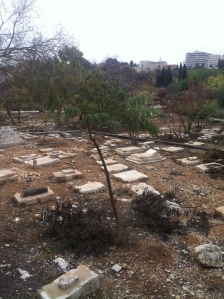A little sight-seeing today.
Mamilla Cemetery is located just west of the Old City of Jerusalem. The space has been the site of places of worship, shrines and cemeteries since the Byzantine period (IV to VI centuries) and early Islamic period. Thousands of Christians were buried there in the pre-Islamic period, and a church stood on the site. It has been an Islamic cemetery at least since the Rashidun Caliphate (VII century), except during the Crusader period. In 1927 the Supreme Muslim Council, which was the high authority for the Muslim community under the British mandate, decreed an end to burials at Mamilla and declared it a historic site.
When the cemetery came under Israeli control in 1948, it was declared an abandoned property and as such came under the authority of the Guardianship of Absentee Property. By 1967, both vandalism and official building schemes had brought much of the cemetery to a derelict condition. There is still a great deal of controversy surrounding Israeli actions and plans with regard to the site.
I went through a corner of Mamilla Cemetery on a walk with my friend S this week, and took a few pictures with my telephone.

Mamilla Cemetery seen from the street. Note the one completely restored tomb among the many ruins.

Marker in Hebrew and Arabic, reading:
State of Israel
Protected Site
Keep this place clean.
Please do not introduce animals or alcoholic beverages.

A shrine (I believe) in the cemetery grounds. There are a number of Sufi shrines here, as well as the tombs of other mystics, emirs, muftis, and Jerusalem notables, as it was the largest Muslim cemetery in the area.

The door to the shrine.

The inside of the structure, taken with flash between the bars of the window. The presence of plastic jugs and bags of cement seem to indicate that it is under repair and renovation.
LOVE this post! Very interesting and nice photos.
What a fascinating lace to wander through!
Blessings and prayers
Maxine
ooops – typo – should be fascinating place!
Thanks for the comments and the “likes”. It is an interesting place. Maybe I’ll have the time and strength one day to go wandering through with my real (i.e. non-phone) camera. Kind of you to comment on the photos, Judy, when yours are so very good. 🙂
Please check out http://www.mamillacampaign.org for the full story on Mamilla
Thank you, Raja. Since this isn’t a political blog, I kept my comments more general. The link you provided gives much more information about some aspects of the Mamilla story.
Thanks for reading. I hope you’ll stop by again.
Before it became a political issue, Mamilla was a historical, cultural, archeological, religious story. And still is, however much the politics threatens all that. A picture without a story context can be nice, but its never enough since every picture begs new questions – like the one with the marker about the same State of Israel protecting the site which is also desecrating it – I wish you had also included a picture of that part of the cemetery which has been allocated for the construction site of the planned “Museum of Tolerance” (?!). But thanks for the visit anyhow, it helps to emphasise that this indeed is a sacred site.